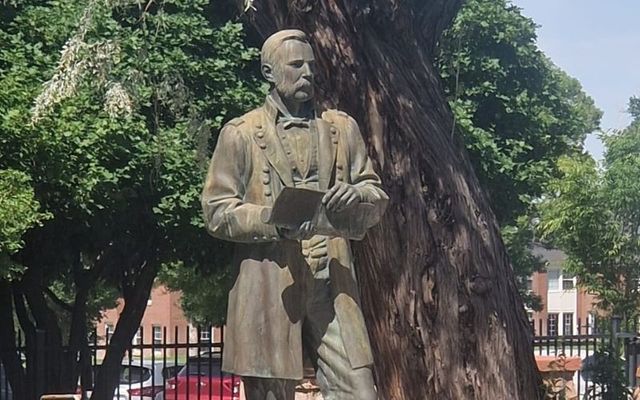160 years ago, 200 soldiers of the Union army marched out from their fort at Salt Lake City Utah, and engaged the Native American Shoshone tribe at its winter encampment at Bear River in what is present-day Idaho.
What followed was a brutal massacre of over 450 men women and children. It’s the largest such massacre of Native Americans in US History, which is saying something.
The man who led the expedition was born and raised in Ballywiheen, Ballyferriter, Co Kerry but through emigration and adventure came to be a Colonel at the head of the Stockton Blues, stationed in Salt Lake City Utah during the US Civil War.
Patrick O’Connor, or P Edward Connor as he came to style himself, had already lived a life of war and California gold rush adventure before he rejoined the army at the head of men from the Golden State intending to go fight for the union in the Eastern theatre of the civil war.
Abraham Lincoln and his army command had other ideas.
Lincoln needed a federal government presence in the expanding settlement of Salt Lake City – formed by adherents to the Church of Latter Day Saints under their president Brigham Young.
The government didn’t trust the Mormons, fearful they may try to set up their own country, or worse join the Confederacy and cut off communication with the wealthy west coast.
Connor had used the army to move up the social ladder in the US at a time when Nativist sentiment was violently anti-Catholic and anti-Irish.
While in Utah, frustrated at being denied the chance for battle glory in the east and at not being allowed to take a firmer hand with the Mormons, the North Western Band of the Shoshone tribe became the target of his frustrations and ambitions.
Following the killing of a miner (who like other Euro-American settlers was increasingly traveling into and through the traditional hunting grounds of the Shoshone) Connor had the excuse he needed for an expedition.

Love Irish history? Share your favorite stories with other history buffs in the IrishCentral History Facebook group.
The local federal Marshal sought Connor's help in arresting several chiefs of the tribe.
Connor informed him he was welcome to come along but that he would not need his warrants as it was not his intention to make any arrests.
The Colonel then took his troops out by night in sub-zero temperatures on the arduous journey to Bear River, crossing mountain passes in blizzard conditions they lost 70 men to illness and frostbite along the way.
On January 29th, 1863, they arrived at the traditional winter encampment of the Shoshone and after an ill-judged frontal charge on the camp during which they lost 14 men, Connor ordered his troops to flank the Shoshone village and the real killing began.
Mutilation, torture, rape, and death followed over the next few hours.
Shoshone Chief Bearhunter was killed by his captors running a red hot bayonet from ear to ear.
The soldiers were worried their ammunition would run out so Infants were picked up by the ankles to have their heads bashed out on rocks and many fleeing Shoshone found a watery death in freezing the river.
One survivor, Anzee-Chee, hiding from the soldiers with 10 other women under an overhanging river bank drowned her newborn child when it started to cry for fear of giving up their position.
Connor was promoted to Brigadier General as a reward for the ‘Victory’.
The Shoshone survivors converted en masse to the Church and adapted to farming with the help of the Saints.
The massacre was painted as a battle and stayed that way on the official record for over 100 years.
Today, there is a statue of Patrick Edward Connor at the Fort Douglas Military Museum describing him as a soldier statesman of great energy and vision.
There is no mention of Bear River.
Statue aside, the event and Connor himself were forgotten by history.
However, the Shoshone did not forget and tribe members like Mae Timbimboo Parry campaigned for decades to have the official record changed to tell the truth of what happened that day.
She lobbed Congress, presented evidence, and succeeded in getting the government to describe the event for what it was.
Today her Grandson Darren Parry has led the tribe's project that purchased the massacre site and is planning to build an interpretative center there.
Bear River was forgotten for a reason, it’s an uncomfortable reminder of how the America of today came into being, the death and brutality dealt to the native peoples by the American Government in its push to colonize and ‘civilize’ the continent from sea to shining sea.
Patrick Edward Connor’s part on that day and his subsequent brutal actions during the Power River campaign against the Arapaho is an uncomfortable truth about the Irish emigrant role in this darker side of the American story.
If we celebrate John F. Kennedy and Joe Biden, we should also account for the story of Kerry’s frontier general.
You can listen to "Gloryhunter - Kerry's Indian Killer" here via Spotify:
*Jerry O'Sullivan is a journalist and presenter with Radio Kerry. His radio documentary "Gloryhunter - Kerry's Indian Killer" tells the forgotten story of Connor's involvement in the Bear River Massacre and looks at how and why we remember, commemorate, and forget history.




Comments